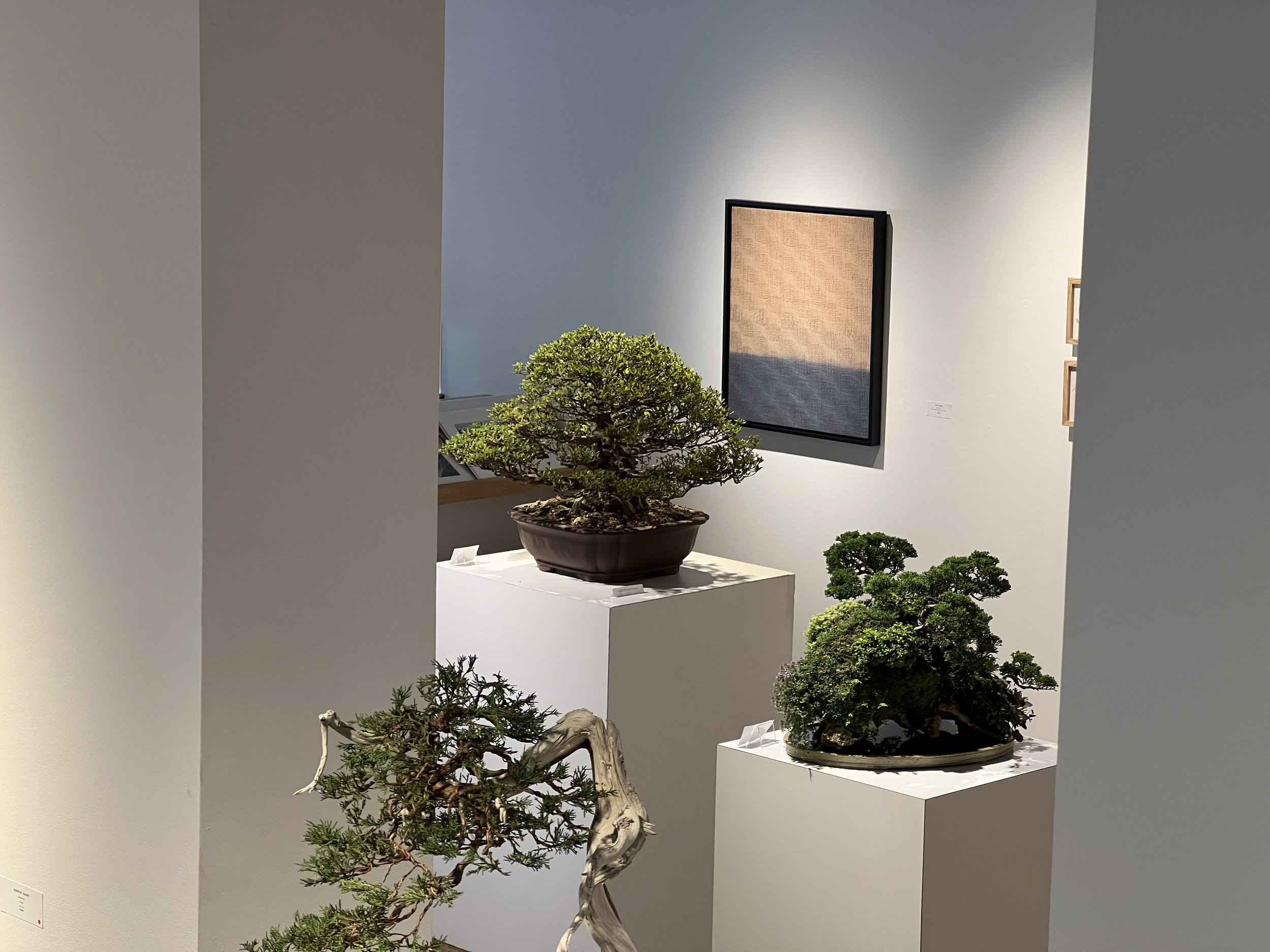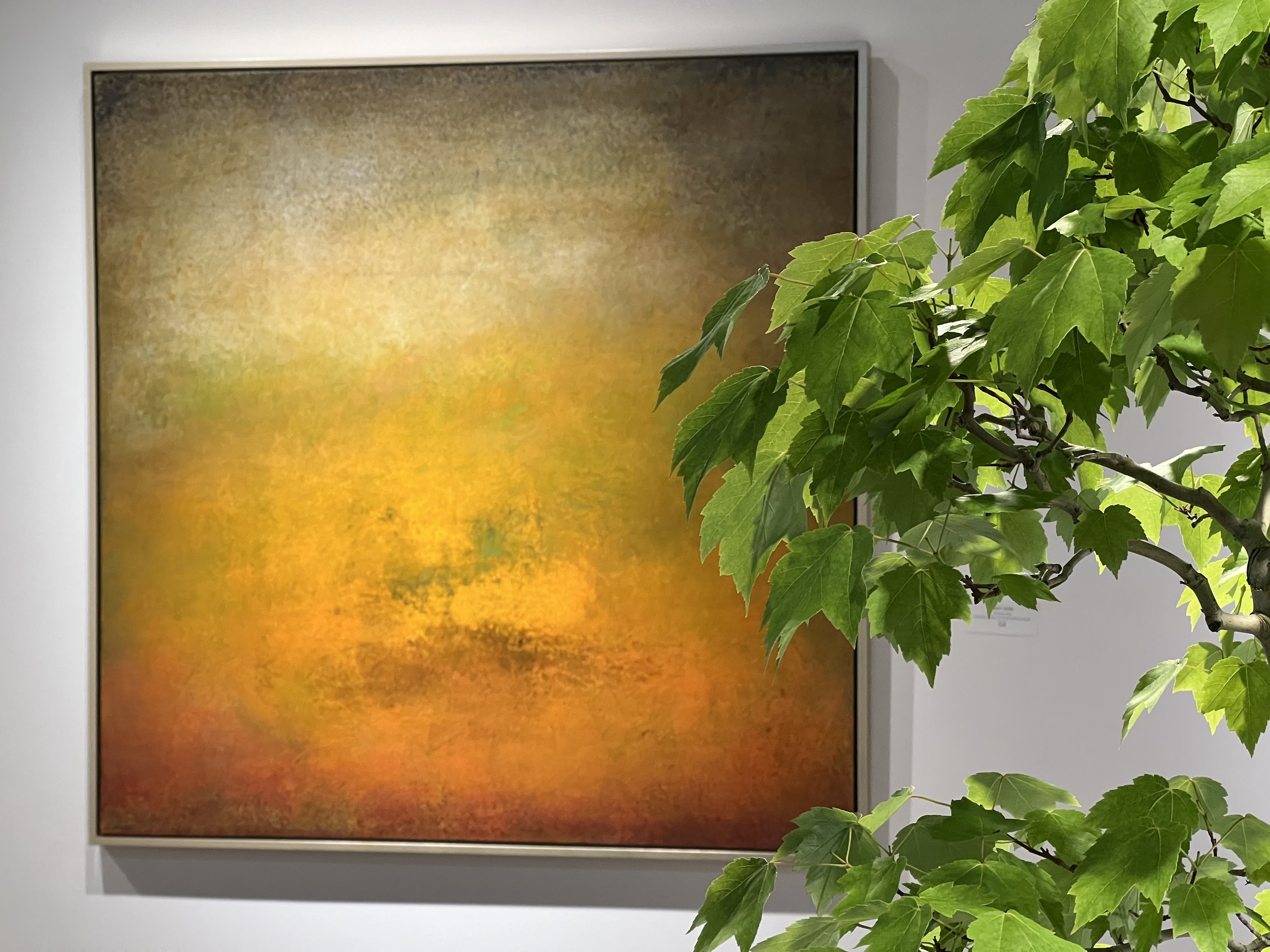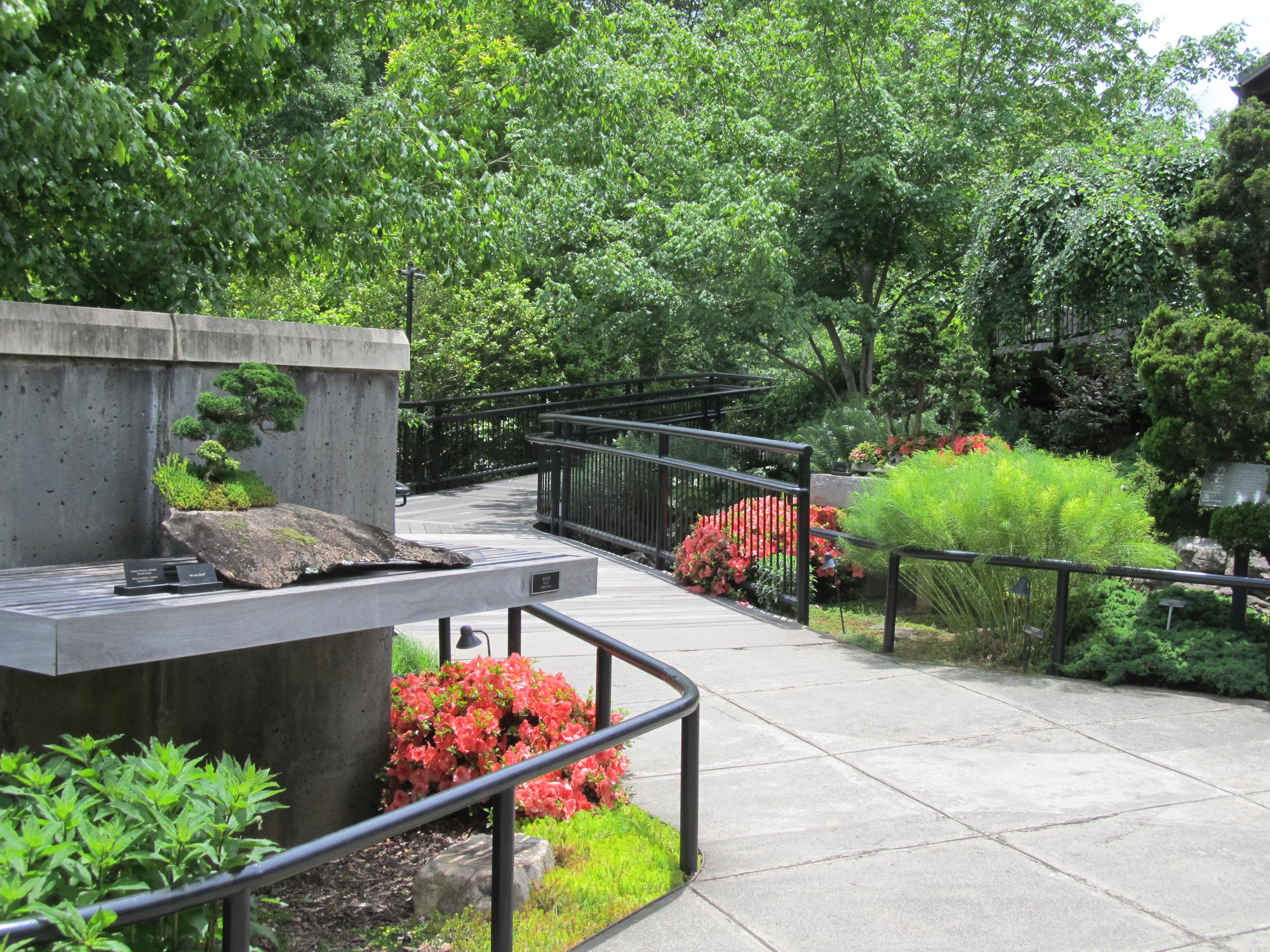Bonsai as Fine Art?
A person ought not walk on ice. Ice is slippery and hard, and although you might move across it carefully, thinking you are doing okay, suddenly your feet are flying out in front of you and gravity yanks you down from behind. When you hit the hard ice you get hurt. Best altogether to avoid walking on the stuff, if it is avoidable.
Talking about art is the same way. It is best to avoid talking about art, but sometimes the subject seems impossible to avoid and then one is best advised to go about it cautiously. Bad outcomes seem all too likely.
In June of this year, Blue Spiral 1, the prestigious downtown Asheville art gallery, hosted a display of bonsai. The title of the show was Bonsai as Fine Art. Visitors to the exhibit found a selection of ten bonsai displayed on plain white pedestals, arranged throughout the large, open main floor of the gallery. Displayed on the walls all around the bonsai were painted works of art, generally dealing with views of nature, some representational and some abstract. The overall effect of the presentation was a quietly pleasing meditation on the natural world, with bonsai bringing focus on the central motif of trees. Many people came through during the ten days of the exhibit. Some were there specifically to see the bonsai, but many others were there to see the artwork one would expect to find in a fine art gallery: paintings, drawings, prints, photographs, sculpture, assemblages, ceramics, wood works, blown glass, forged metal, and other creative expressions in a wide range of media. And for a brief time there were bonsai plantings among them. Blue Spiral 1 director Michael Manes, in his remarks at the opening reception for the Bonsai as Fine Art exhibit, joked that he often likes to say the art in the gallery is "alive," and in this instance it actually was.
Attribution: Stuart Rogers
Attribution: Felix Laughlin
Attribution: Felix Laughlin
Showing bonsai within the context of a place where people go to see fine art was the inspiration of Mr. Felix Laughlin, who has pursued the practice and study of bonsai for forty years. That interest has taken him to various parts of the world, especially Japan, and led to Felix becoming a leading bonsai advocate in the United States. He was one of the founders of The National Bonsai Foundation in Washington, DC, serving for a long while as its president. He also put in a term as chairman of the World Bonsai Friendship Federation. There is no doubt in Felix's mind that bonsai is an art form, but it bothers him that many people fail to recognize the creation of containerized miniature trees and landscapes as such. His idea was to have a bonsai show in a venue that is unmistakably intended for the display and appreciation of art, to make the point that bonsai belongs there. Or maybe the idea was to give people a clue: See all the nice art around here? See the bonsai? The bonsai is art, too. Whatever the impetus was, Felix's idea proved sound. The Bonsai as Fine Art exhibit was an admirable success. The little trees fit in comfortably with the paintings all around them, in the very reputable gallery filled from top to bottom with refined works of art of all description, and no one was heard to express any word against bonsai belonging in that company. Everything looked beautiful.
Attribution: Felix Laughlin
Attribution: Felix Laughlin
Attribution: Felix Laughlin
All well and good, but does that make bonsai art? Were all the paintings hanging in the gallery at the time of the show truly art? The many other objects on display in the gallery, made of all the different media, in two dimensions or three, large or small, decorative or functional — were they all art? Everything looked beautiful. Fine, even. But was everything art? Who gets to decide that? What is art anyway?
Watch out for the ice!
Here is what Merriam-Webster has to say about it: "art: noun — the conscious use of skill and creative imagination especially in the production of aesthetic objects." That is not a bad way to frame what we are talking about, when we talk about fine art. By itself, however, that definition seems to be lacking. What is the purpose behind consciously applying skill and creative imagination in the production of whatever it is the artist produces? Perhaps a purist would respond that art does not need a purpose, that a piece of art exists for itself and there is no need for justification. That makes art sound very mysterious, or maybe a little stuffy. Perhaps art is entirely for the benefit of the one who creates it, so making art is all about expressing yourself. Personal expression certainly seems to belong somewhere in the definition of art, but is that all there is to it? Something creative gets produced, but then what? It does not seem the act of creating, by itself, constitutes art. Art requires that the creative product be made available to others, and the need for getting the work out there is an important point. Art cannot exist in a vacuum. When a person strives to create art, they are using skill and imagination to express something they think or feel, and then that expression is intended to be experienced by other people. This way of looking at it puts the "art for art's sake" idea off in a corner to contemplate itself. Art is for people's sake, for the sake of creatively communicating to the rest of the world a personal perspective, in hopes that it will resonate with others.
If that is how we define art, then of course bonsai can be art. For example, bonsai can be used to creatively express a personal experience of nature. Bonsai can be art, but it does not have to be. The act of doing bonsai is not automatically an artistic endeavor. That is the same situation as exists for painting, sculpture, music, dance, or any other activity that might be used to produce art. There is an intention involved, and there is a vehicle — or medium — used for creative personal expression, and then there is the element of connection with an audience.
There are places that exist exclusively for the purpose of connecting personal creativity with a potentially receptive audience. In the world of visual art some of these places are known as art museums and art galleries. Exhibiting bonsai in an art gallery provides a stage for bonsai to be appreciated as fine art, but being in a gallery is not what makes bonsai fine art. The combined effect of intention, imagination and skill employed in the creation of the bonsai, and how well that bonsai then communicates with viewers who encounter it in the gallery, is what will ultimately determine artistic merit. For all that, any place bonsai might be seen provides a context in which deserving bonsai may be legitimized as art. Art of any type is where you find it.
At The North Carolina Arboretum, bonsai is presented as art. The Arboretum's bonsai collection is an art collection. The Bonsai Exhibition Garden, where the Arboretum's bonsai are usually viewed, might be thought of as a large, living piece of interactive art in its own right. The bonsai and the garden designed expressly for displaying the bonsai are artistic expressions of the human experience of nature. Many of the visitors who come to the garden intuitively understand this intention and connect with it. There is a communication going on that is born of imagination and creativity and there is an audience that receives and affirms the message. The truth of this can be ascertained by spending time in the garden, observing the people who pass through it and listening to what they say. They behave very much like people in an art gallery.
The Bonsai as Fine Art exhibit was a collaborative venture, combining resources from the Blue Ridge Bonsai Society and The North Carolina Arboretum, coordinated and curated by the staff of the Blue Spiral 1 art gallery. It took a great deal of effort by many people to realize Felix Laughlin's dream. The result was that for ten days in June people who might have had a hard time grasping the idea of bonsai being a fine art could see tangible evidence laid out before them, and judge for themselves. For those who already thought of bonsai as having the potential to be art, the exhibition was a fine show of trees in a unique setting. Those who did not get to see Bonsai as Fine Art missed an aesthetically stimulating experience.
Attribution: Felix Laughlin








